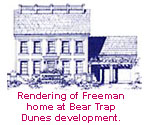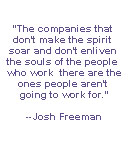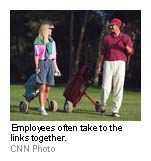|
Stopping employee flight
|
 |
March 7, 2000: 5:56 a.m. ET
One Md. real estate developer reveals his secrets for retaining employees
By Staff Writer Hope Hamashige
|
NEW YORK (CNNfn) - Like all CEOs, Josh Freeman has ultimate responsibility for making sure his company turns a profit and grows at a steady pace. He is also in charge of seeing that his team delivers a quality product and that his employees are compensated fairly and treated well.
What sets him apart from his peers is his desire to make his real estate development company, Carl M. Freeman & Associates, a place where people are not just pleased, but ecstatic, to work.
"The companies that don't make the spirit soar and don't enliven the souls of the people who work there are the ones people aren't going to work for," Freeman said.
Ah, the American workplace. The institution that spawned phrases like "Monday morning blues" and "Thank God It's Friday." It's not exactly the first place that comes to mind when people consider the things and places in their lives that make them feel most alive.
Keep them happy and keep them here
It may sound more like hokey philosophy than sound business practice, but Freeman has found that keeping people happy has helped him maintain a very low turnover rate in a highly competitive environment.
 In a market with an average of 22 percent turnover in 1998 among businesses with fewer than 500 employees, according to the Human Resource Association of Metropolitan Washington, D.C., turnover at Freeman's Potomac, Md.-based company was less than 13 percent that same year. In a market with an average of 22 percent turnover in 1998 among businesses with fewer than 500 employees, according to the Human Resource Association of Metropolitan Washington, D.C., turnover at Freeman's Potomac, Md.-based company was less than 13 percent that same year.
In this tight labor market, keeping employees is increasingly difficult. Most employers try to deal with the problem by throwing money at it -- raising salaries and adding benefits.
Freeman has done neither. Salaries are "competitive" for the real estate industry, but not extravagant. The benefits -- which include both a "cafeteria" style benefits plan and 401(k) retirement plan -- are generous, but also not extravagant. He hasn't focused on raising salaries because that doesn't address one of Freeman's core beliefs -- that so long as they are making a decent living, people will choose to work at a company that values them and respects them.
What kind of company do you want to work for?
It all started a few years back when Josh Freeman, then 30, sat down with executive vice president Mike Nally to talk about the future of the family business. Freeman had taken a more active role in running the company after his father had a stroke in 1992. He was appointed CEO when Carl M. Freeman died in 1998 in a car accident.
"We talked about what kind of company we would want to work for," said Freeman, now 35. "We wanted to make it challenging both personally and professionally."
Freeman employees are expected to improve their skills over the years they spend with the company. To guarantee that, the company requires each  employee to complete 40 hours of training every year. Classes are offered at the company, through a program called Freeman University, but the company also will pay for any kind of outside training or schooling employees wish to receive. Freeman Cos. maintains a $1 million training budget. employee to complete 40 hours of training every year. Classes are offered at the company, through a program called Freeman University, but the company also will pay for any kind of outside training or schooling employees wish to receive. Freeman Cos. maintains a $1 million training budget.
Supervisors are meant to act like coaches: They are supposed to know what job their employees aspire to have and they help them develop the skills they need to get there.
Many employees have taken advantage of the tuition reimbursement program to put themselves through college or graduate school, said Freeman, including two who went to law school at night.
Though Freeman has high expectations for his employees, the atmosphere at the office is casual and family-like. He brings his dog, Guinness, to work every day and it is not unusual to see kids at work with their parents on days when day care is unavailable.
The company that plays together, stays together
Another of Freeman's core management beliefs is that people function better and are more loyal when they feel they are part of a team. To that end, he has created programs and incentives for employees to work, eat and play together.
Lunch, cooked by the company chef, Gertrude, is free to employees Monday through Thursday. The atmosphere turns casual and conversation tends to drift away from work and toward family and sports each afternoon as employees sit together, break bread and enjoy one of Gertrude's gourmet specialties.
In addition to eating together, many work out together in the gymnasium that Freeman built in the office for the use of his employees. A devoted athlete himself, Freeman often works out during the day and encourages everyone at the company to run and lift weights whenever they feel the need.
 To encourage the bonding that comes from competing together, Freeman pays entrance fees for his employees to participate in sporting competitions. Last year, the company paid the way for more than a dozen employees who competed together in the Marine Corps marathon. This year, Freeman is trying to put together a team to run in a 50-mile race. To encourage the bonding that comes from competing together, Freeman pays entrance fees for his employees to participate in sporting competitions. Last year, the company paid the way for more than a dozen employees who competed together in the Marine Corps marathon. This year, Freeman is trying to put together a team to run in a 50-mile race.
The company recently moved into golf course development, so many employees take to the links together before the workday starts.
Part of making his management style work, said Freeman, is finding people who want to work with a very tight-knit group of people in a place that encourages teamwork.
"We don't have a culture that attracts individualists so much as people who want to work on a team," said Freeman. "The individualists wouldn't enjoy their time here." 
|
|
|
|
|
 |

|

